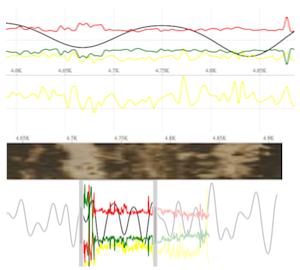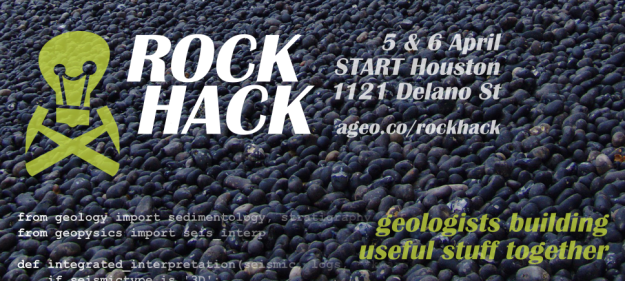Hacking logs
/
Over the weekend, 6 intrepid geologist-geeks gathered in a coworking space in the East Downtown area of Houston. With only six people, I wasn't sure we could generate the same kind of creative buzz we had at the geophysics hackathon last September. But sitting with other geoscientists and solving problems with code works at any scale.
The theme of the event was 'Doing cool things with log data'. There were no formal teams and no judging round. Nonetheless, some paired up in loose alliances, according to their interests. Here's a taste of what we got done in 2 days...
 Multi-scale display
Multi-scale display
Jacob Foshee and Ben Bougher worked on some JavaScript to display logs with the sort of adaptive scrolling feature you often see on finance sites for displaying time series. The challenge was to display not just one log with its zoomed version, but multiple logs at multiple scales — and ideally core photos too. They got the multiple logs, though not yet at multiple scales, and they got the core photo. The example (right) shows some real logs from Panuke, a real core photo from the McMurray, and a fake synthetic seismogram.
Click on the image for a demo. And the code is all open, all the way. Thanks guys for an awesome effort!
 Multi-scale log attributes
Multi-scale log attributes
Evan and Mark Dahl (ConocoPhillips) — who was new to Python on Friday — built some fascinating displays (right). The idea was to explore stratigraphic stacking patterns in scale space. It's a little like spectral decomposition for 1D data. They averaged a log at a range of window sizes, increasing exponentially (musicians and geophysicists know that scale is best thought of in octaves). Then they made a display that ranges from short windows on the left-hand side to long ones on the right. Once you get your head around what exactly you're looking at here, you naturally want to ask questions about what these gothic-window patterns mean geologically (if anything), and what we can do with them. Can we use them to help train a facies classifier, for example? [Get Evan's code]
Facies from logs
In between running for tacos, I worked on computing grey-level co-occurence matrices (GLCMs) for logs, which are a prerequisite for computing certain texture attributes. Why would anyone do this? We'd often like to predict facies from well logs; maybe log textures (spiky vs flat, upwards-fining vs barrel-shaped) can help us discriminate facies better. [Download my IPython Notebook]
Wassim Benhallam (of Lisa Stright's Rocks to Models lab at University of Utah) worked on machine learning algorithms for computing facies from core. He started pursuing self-organizing maps as an interesting line of attack, and plans to use MATLAB to get something working. I hope he tells us how it goes!
We didn't have a formal contest at this event, but our friend Maitri Erwin was kind enough to stop by with some excellent wine and her characteristically insightful and inquisitive demeanour. After two days rattling around with nothing but geeks and tacos for company, she provided some much-needed objectivity and gave us all good ideas about how to develop our efforts in the coming weeks.
We'll be doing this again in Denver this autumn, some time around the SEG Annual Meeting. If it appeals to your creativity — maybe there's a tool you've always wished for — why not plan to join us?
As I get around to it, I'll be dumping more info and pictures over on the wiki.











 Except where noted, this content is licensed
Except where noted, this content is licensed